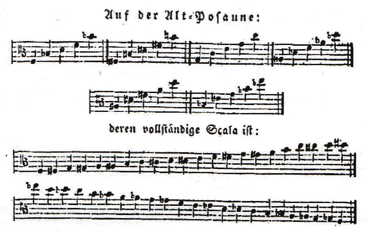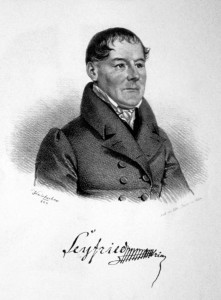Made the below update about Seyfried’s edition of Albrechtsberger’s treatise to the Alto in Treatises page. This is a significant piece of the puzzle in the history of the alto trombone because 1) the original Albrechtsberger treatise does not provide enough information to definitively distinguish the key of the alto trombone, particularly if you acknowledge the relatively-common historical practice of “falset tone” technique–lipping notes–in brass performance practice; 2) Seyfried was in a uniquely qualified position to clarify the issue, given that he was not only a student of Albrechtsberger’s, but he was also a particularly active Viennese composer and conductor who was intimately familiar with Viennese instrumentation practices; and 3) Seyfried’s edition clearly establishes the Viennese alto trombone as an instrument in E-flat.
 1826—Vienna, Austria: Ignaz von Seyfried, in his revision of Albrechtsberger’s treatise of 1790 (Sämmtliche Schriften), clarifies the pitch of the alto trombone as E-flat, appending the facing alto trombone position chart (see facing image; public domain) (Albrechtsberger-Seyfried). Not only was Seyfried in the unique position of having been a pupil of Albrechtsberger’s, but he proceeded to become an active Viennese composer and conductor as well. “His versatility,” explains Grove’s, “won him a unique place in Vienna’s musical life.” He regularly conducted at least 2 orchestras in Vienna, supplying them with numerous works himself, and was on friendly terms with many prominent musicians of Vienna, including Mozart and Beethoven. Seyfried conducted the premiere of Fidelio,along with many other early performances of important works of the era (New Grove, Seyfried 184).
1826—Vienna, Austria: Ignaz von Seyfried, in his revision of Albrechtsberger’s treatise of 1790 (Sämmtliche Schriften), clarifies the pitch of the alto trombone as E-flat, appending the facing alto trombone position chart (see facing image; public domain) (Albrechtsberger-Seyfried). Not only was Seyfried in the unique position of having been a pupil of Albrechtsberger’s, but he proceeded to become an active Viennese composer and conductor as well. “His versatility,” explains Grove’s, “won him a unique place in Vienna’s musical life.” He regularly conducted at least 2 orchestras in Vienna, supplying them with numerous works himself, and was on friendly terms with many prominent musicians of Vienna, including Mozart and Beethoven. Seyfried conducted the premiere of Fidelio,along with many other early performances of important works of the era (New Grove, Seyfried 184).
